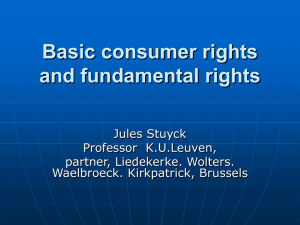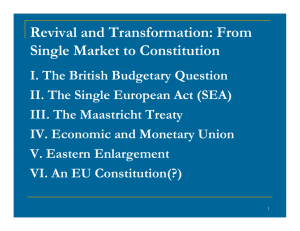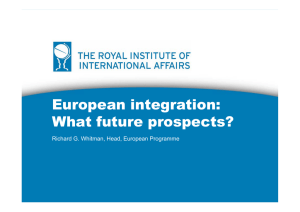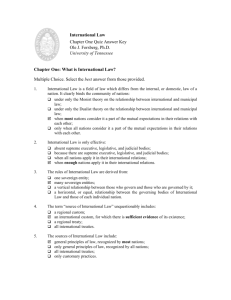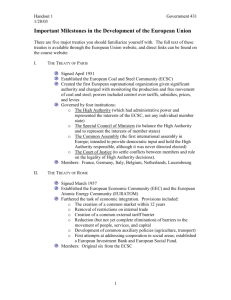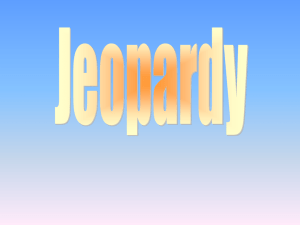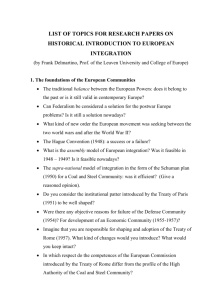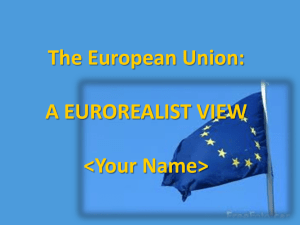political
advertisement
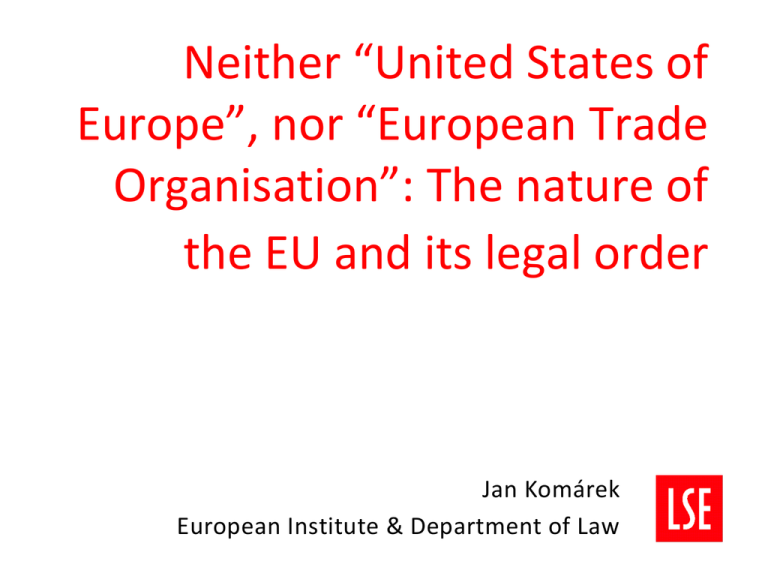
Neither “United States of
Europe”, nor “European Trade
Organisation”: The nature of
the EU and its legal order
Jan Komárek
European Institute & Department of Law
Various narratives of the European
Integration
two extremes: 'European Trade Organisation' vs. 'United
States of Europe
different disciplines' narratives: political science/political
theory ("politics") vs. law (and different fields of law –
constitutionalists' biases)
different "keywords": state, constitution, delegation,
control, government...
the Q for us: what legal form for what kind of Union? (and
implicitly: does the form matter?)
Politics
explanatory/analytic theories vs. normative theories
(some) great controversies:
is the EU a political system?
what motivates further integartion (the role of state interests
vs. supranational institutions)
neofunctionalism: Ernst Haas, William Sanholz, Alec Stone
Sweet
the COM, the ECJ
(liberal) intergovernmentalism: Andrew Moravcsik, Alan
Milward
the Council, IGCs
federalism/cosmopolitanism: Jürgen Habermas
"the people"
Law
what legal form does/should the EU have?
what kind of (legal) authority?
what is the basis for that authority: the consent of the
Member States or an agreement among the people(s) of
Europe?
does Europe have a constitution? does it need one?
is there European 'demos'?
is the European demos necessary to keep the EU legitimate?
(how) can it be established?
DEBATE
Does the EU have a
constitution? Does it
need one?
The key moments: the establishment
The context:
the end of WW2 – end of nationalism?
the Marshall Plan for Europe
the significance of the Cold War
the ideology of the (free-market) rights-based liberalism
(GATT 1947, ECHR 1950, UN Universal Declaration of Human
Rights 1948)
Schumann Declaration 1950:
'Europe will not be made all at once, or according to a single plan. It will be
built through concrete achievements which first create a de facto solidarity.
The coming together of the nations of Europe requires the elimination of the
age-old opposition of France and Germany. Any action taken must in the first
place concern these two countries.
With this aim in view, the French Government proposes that action be taken
immediately on one limited but decisive point.'
The establishment
The Founding Treaties:
only 6 MS: GER, FRA, ITA, BEL, NDL, LUX
1951 ECSC, effective 1952, expired 2002
1957 EEC and Euratom, the Treaty of Rome, effective 1958
the key features:
'determined to lay the foundations of an ever closer Union
amongst the Peoples of Europe'
four freedoms of the Common Market
own institutions for creating and enforcing rules: High
Authority (COM), Council, Assembly (EP), ECJ
a new and autonomous legal order (is this stated somewhere
in the treaties themselves?) – the process of the
'constitutionalisation' of the Treaties
Establishing the legal authority of the EU
direct effect and primacy: Van Gend en Loos + Costa v ENEL
fundamental rights: Internationale Handelsgesellschaft
competence(-competence): ERTA
Constitutional rhetoric (only?)
JHH Weiler:
'critical aspects the Community has evolved and behaves as
if its founding instrument were not a Treaty governed by
international law but, to use the language of the European
Court of Justice, a constitutional charter governed by a form
of constitutional law'
Case 294/83 'Les Verts' – the Treaty as 'the basic
constitutional charter'
Opinion 1/91 EEA – the same
the rise of the EU constitutional scholarship
Beyond the 'Integration through Law'
strict autonomous legal authority of the EU vs. a rather
elusive political authority
prevalence of unanimous voting in the Council
weak EP (just in 1962 renamed to EP)
the 'empty chair crisis': 1965 --- the Luxembourg
compromise 1966
little progress in the legislative harmonisation of the rules
applicable within the Common Market --- 1979: Cassis de
Dijon ruling of the ECJ (Case 120/78)
in 1986 the number of the MSs doubled
the Single European Act 1986:
QMV introduced
express competence in social sphere, the environment, ... --moving beyond the common market paradigm
1992: The Treaty of Maastricht
1989/90: the fall of the Berlin Wall, the collapse of the
Soviet Union
plans on a further enlargement of the EU: a wider Europe
a deeper integration beyond the Common Market?
Maastricht: economic and political union, at the price of
fragmentation ('Europe of bits and pieces')
EMU
three pillars, only the first 'supranational', applying the
'community method'; opt-ins + opt-outs
EU citizenship
co-decision legislative procedure – the empowerment of the
EP (versus the lack of interest of European citizens)
the first strong reaction from some Member States: Danish
referendum; the Maastricht judgment of the BVerfG (and
other CCs)
1990s' and 2000's: 2 decades of selfdoubt
1997: The Treaty of Amsterdam
Area of Freedom Security and Justice: definitely moving from the
Common Market paradigm to ...?
Treaty re-numbering
2000: The Treaty of Nice
preparing for the next Enlargement – institutions
2004: The 'Big-Bang Enlargement' and the failure of the
Treaty Establishing a Constitution for Europe:
Joschka Fischer's speech at the Humboldt University (Berlin, 2000)
Laeken Declaration on the Future of the European Union (2001)
The Convention (presided by Valéry Giscard d’Estaing) – Feb 2002 July 2003
rejected in May and June 2005 in NDL and FRA
2008: The Treaty of Lisbon
'the constitutional concept abandoned' (the EU Presidency
Conclusions, Brussels 2007)
two treaties: TEU + TFEU
BUT: 'old wine in new bottles?'
extension of QMV + co-decision with the EP – 'ordinary legislative
procedure'
simplified procedures to amend the Treaties
President of the Council (Van Rompuy) and High Representative
(Catherine Ashton)
EU Charter + Protocols (UK + POL)
2010-: the crisis of Euro as the crisis of
Europe
Treaty on Stability, Coordination and Governance in the
EMU, December 2011
integration outside the EU?
using some institutional mechanisms of the EU
multi-speed Europe
DEBATE
The EU of 27 (or more)
cannot work.
